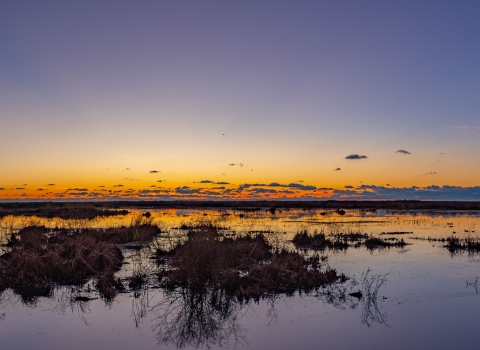The U.S. Fish and Wildlife Service has taken action towards providing relief to fish production facilities that are suffering significant economic losses due to predation of their fish stocks by double-crested cormorants. The Environmental Assessment released today was completed by the Service under the National Environmental Policy Act (NEPA) in consultation with the U.S. Department of Agriculture’s Animal and Plant Health Inspection Service Wildlife Services. It evaluated options for issuing individual permits to lethally control cormorants (known as depredation permits) while ensuring the long-term health of the cormorant population.
Cormorants can feed on fish raised for human consumption and on fish raised for other commercial purposes. In addition, cormorants may cause economic damage to property as well as other damage and conflicts associated with increasing populations.
The EA analyzed options for the issuance of depredation permits for cormorants where there is either significant economic damage to aquaculture facilities, significant damage to native vegetation, significant impact on a threatened or endangered species or significant human safety risks.
It provides a strong biological foundation to ensure cormorant populations are managed responsibly and in compliance with federal laws and regulations, while balancing economic development, human health and safety, endangered species management and other priorities.
Upon publication in the Federal Register on November 15, 2017, aquaculture facility managers and property owners across 37 central and eastern states and the District of Columbia will be able to apply for individual permits for lethal take of double-crested cormorants. The Service expects to begin issuing actual permits prior to cormorant migration this fall.
This review did not include potential damage to recreational and commercial fishing by cormorants. Over the next year, the Service will engage stakeholders in order to assess the biological, social and economic significance of wild fish-cormorant interactions, and to identify a suite of management alternatives. This will include identifying the monitoring needs necessary to address the issue and gathering better scientific information that could be used in the NEPA review and decision making process.
The scale and complexity of the issues involving cormorant control to protect wild free-swimming fish populations is substantial, and not as easily assessed as the impacts on aquaculture. The Service will work with states and tribes to compile scientific information regarding the biological and economic effects of cormorants or their removal on wild fisheries.
The Service is also currently working with state fish and wildlife agencies to assess comprehensive management options for cormorants across the United States.
For more information, please visit: https://www.fws.gov/story/1999-11/service-will-prepare-nationwide-cormorant-management-plan.



